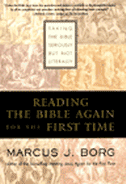Section
|
Reading the Bible Again for the First Time A Cyberspace Discussion Group Foundations: Reading Lenses: History & Metaphor |

Back to Index
| It is recommended to click the Refresh or Reload button to ensure current information. |
|
 Back to Index |
| Click on the 3 sections below for materials according. | ||
| SUMMARY | REFERENCES | COMMENTS |
| REFERENCES |
| COMMENTS Borg makes reference to his "The Meaning of Jesus-Two Visions" that he co-authored with NT Wright. In fact his points on post-critical naivete were apparently first made in this book. Here he quotes the poet TS Eliot And the end of all our exploring will be to arrive where we started and know the place for the first time. It is most important to notice his affirmation at the end of this referred to section in 2Visions, "Because I combine historical Jesus research with a metaphorical and narrative reading of the gospels, I can affirm that both the historical Hesus and the cannonical Jesus matter. One does not need to choose between the two." p 249 Catherine Armstrong in "A History of God" also speaks of these themes of relationship to God. A few quotes: "These myths were not intended to be taken literally, but were metaphorical attempts to describe a reality that was too complex and elusive to express in any other way." p. 5 "Effectiveness rather than philosophical or historical demonstration has always been the hallmark of a successful religion..." p 33. |
 |
St. David's United Church.Calgary, Alberta, Canada.
The United Church of Canada.
October 14, 2001, feb 22, 04